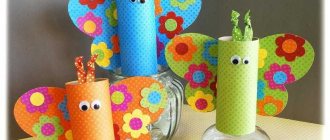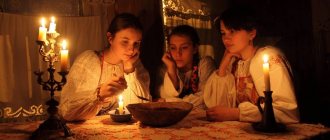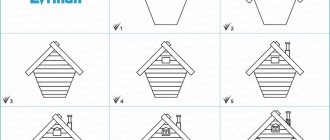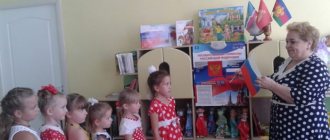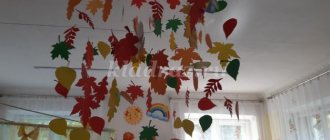Summary of a dominant lesson on listening to music for children 3-4 years old “Who said “Meow?”
Galina OSIPCHUK, music director of the State Educational Institution “Nursery-Garden No. 9, Grodno”
Program objectives: to develop in children the ability to distinguish between noise and musical sounds, to compare and distinguish between high and low sounds; develop musical and auditory perceptions in the process of listening to music, reproduce sounds with the voice easily, melodiously; to cultivate interest in the sound world, goodwill and mutual respect.
Materials and equipment: toys: dog, cockerel, frog, bee, mouse; cups according to the number of children; pieces of paper (according to the number of children); cat hats (according to the number of children); sound recordings: S. Maikapara “In Autumn”, S. Maikapara “Fairy Tale”, Ukrainian folk melody, sounds of nature.
Preliminary work : listening to the works of S. Maykapar.
The phonogram “Sounds of Nature” plays. Children enter the hall freely.
Musical director (hereinafter referred to as M.R.). Guys, what do you hear? (Children's answers).
Yes, we are greeted by the sounds of nature. Are they all the same? (No).
M.R.: No, of course. What sounds do you hear? (Sounds of autumn).
M.R.: Why autumn? (Wind, rain, birds fly to warmer lands). Right.
M.R.: Oh! What do I hear? Have the sounds stopped making noise? And I even know why. Because these sounds are noise. They make noise, like children, sometimes, in a group or on the street.
M.R.: Guys, what other sounds are there? Noise and... (Musical).
Yes, there are noise sounds. Only there are others. Not rustling, not knocking - there are MUSICAL sounds!
M.R.: Absolutely right, all the time in music classes we hear musical sounds. The music is written by the composer. Which composer's plays did we get acquainted with? (Maikapara).
M.R.: Let's try to perform a miracle. We will combine musical and noise sounds. Let's take our noise clouds. To the music of S. Maykapar “In Autumn” we will find ourselves in my favorite fairy tale.
The music of S. Maykapar “In Autumn” is played, the children accompany (paper orchestra).
M.R.: So we flew to visit the dog. How small she is, still just a puppy. Let's say hello to him.
Singing “Hello, Bobik, good dog.”
M.R.: We know a song about him.
The song "Tyav-Tyav!" (music by V. Gerchik, lyrics by Yu. Razumovsky).
M.R.: Now, guys, listen to the story that actually happened to Bobik:
After dinner, our puppy lay down in the corner to sleep. He put his tail under the sofa and hid his wet nose in his paws. (M. Vasilyeva)
M.R.: Our puppy is sleeping, and in his dream he sees a fairy tale. Do you want to be in his dream? And the music of the composer Maykapar, called “Fairy Tale,” will help us. Listen carefully, do not make noise so as not to wake the puppy, move silently, otherwise the fairy tale will end.
Listening – “Fairy Tale” by S. Maikapara (with soap bubbles).
M.R.: Our puppy fell asleep. And at this time...
Suddenly a “meow-meow” sounded very loudly above my ear. Bobik looked under the table and into the cupboard - there was no one in the apartment. The puppy ran into the yard... (M. Vasilyeva)
M.R.: Guys, let’s go outside with the Puppy. (Children walk on their tiptoes to the music and approach the fence on which the Cockerel is sitting.)
M.R.: Guys, look who Bobik met on the street. Who is this? That's right, Cockerel.
Bobik asks the Cockerel: “Did you meow or not? Give me the answer quickly!” And the Rooster said to the Puppy: “I’m singing...” (M. Vasilyeva)
M.R.: Guys, how does the cockerel sing?
Let's all sing loudly together: ku-ka-re-ku!
M.R.: And our Puppy went further. And we will go with him.
The children approach the pond. A fish appears.
Puppy: Was it you, the fish who said: “Meow”?
M.R.: Guys, can a fish say: “Meow”? (No! Pisces don't talk).
M.R.: How come they don’t talk? They open their mouth.
Imitation game "Small and big fish" A frog appears.
Frog: Kwa-ah! Kwa-ah!
Puppy: Did you say “Meow”?
Frog: How stupid you are, Puppy. I just say: “Kwa-a-a!” Kwa-a-a!”
M.R.: Bobik was upset... and suddenly he heard again: “Meow!” And she sat on a flower...
- Who, guys? (Bee).
M.R.: Let's show the puppy how she talks. (W-w-w-w!).
Puppy: Let's run away from here quickly! Now she's going to sting us!
Children walk around the hall to the music and approach the bushes.
M.R.: And again our Bobik heard someone say: “Meow!” The Puppy looked and saw that a small mouse was hiding in the bushes. (Takes out a mouse).
M.R.: Guys, how does the mouse squeak? That's right: pee-pee-pee.
But our Mouse does not live alone, but with her mother. How does the mother mouse squeak?
Game “High-low sounds” (The music director plays one sound in different registers, and the children must say who the voice belongs to).
M.R.: Mice are very nimble animals. They run fast. And they eat the cereal just as quickly. Look, there were grains in these cups recently, but now they are gone. Let's play with them. Let's again combine noise and musical sounds so that our fairy tale does not end.
“Orchestra of Cups” (Ukrainian folk melody)
M.R.: Guys, if a Mouse lives here, then he probably definitely lives nearby... (takes out the Cat).
Puppy : Oh, who is this? (Cat).
M.R.: That's right, Cat. So that's who said: "Meow." Now Bobik knows who woke him up.
That's what she is like. Her paws are soft, she walks silently. And her kittens are playful, cunning, and love to play pranks, like all children. We will now turn into little kittens and hide from our mother cat.
Dance “Grey Cat” (music by V. Vitlin).
The children say goodbye to the Puppy and leave the hall.
